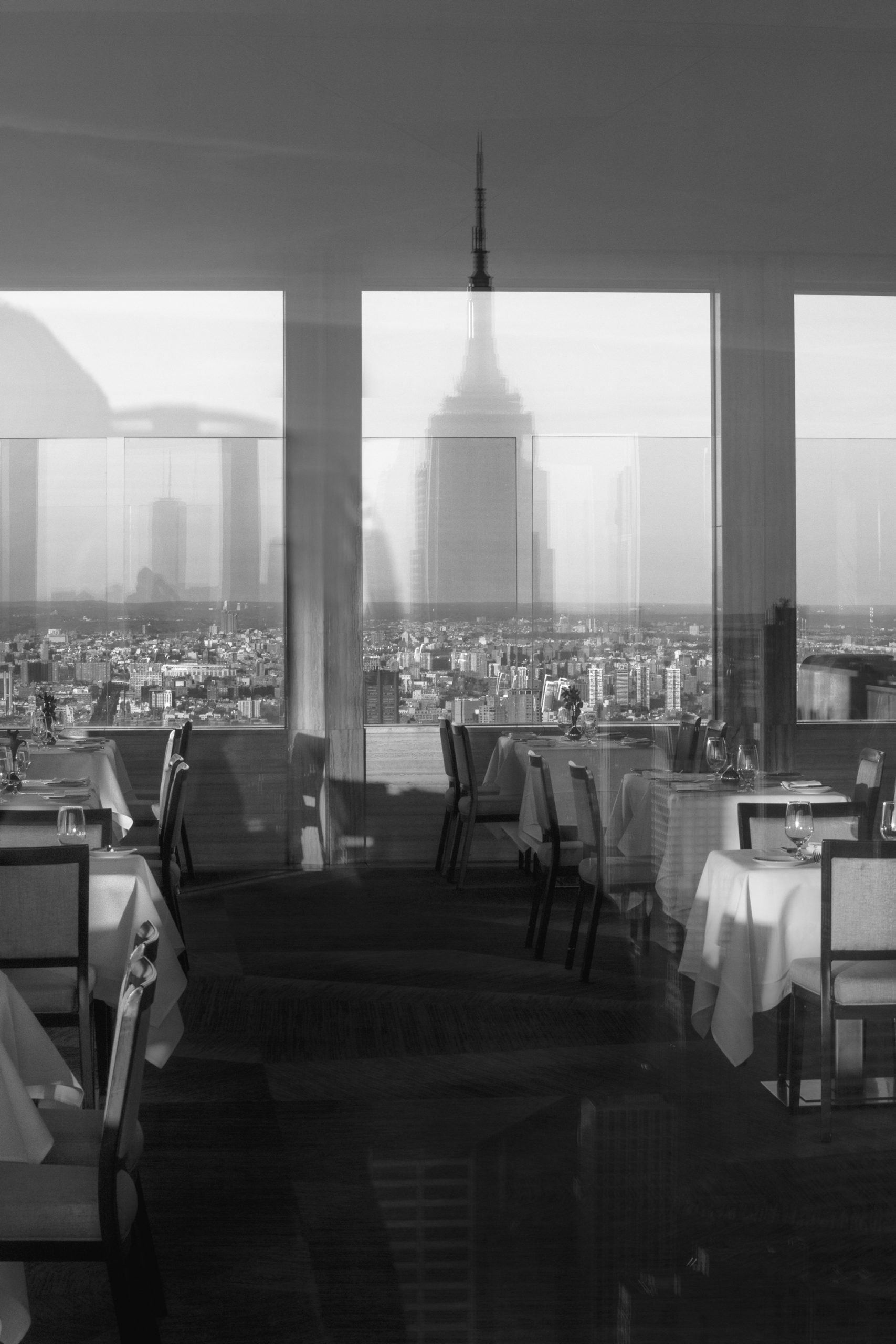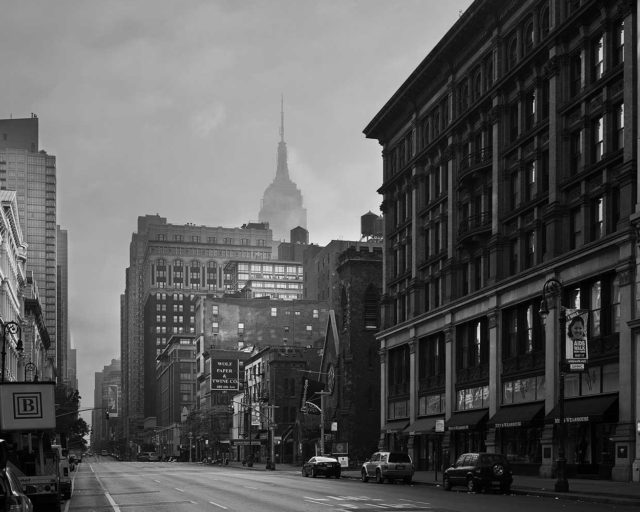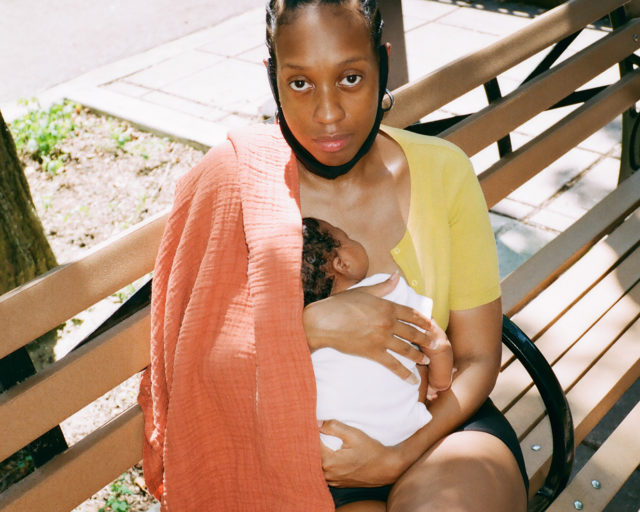Philip Montgomery, The Rainbow Room, 30 Rockefeller Plaza, New York, two days before Thanksgiving, November 2020, for Aperture
In March 2020, within weeks of the first diagnosed cases of COVID-19 in New York, Philip Montgomery began documenting the health-care workers and staff in nine of the city’s hospitals. On his first day, 1,162 new patients had been hospitalized with the disease, and 349 had died. By April 6, his last day, 19,177 people had been hospitalized with the virus in New York, and 3,202 had died. As the story shifted to how New Yorkers would mourn an unimaginable loss, Montgomery chronicled a funeral home in the Bronx, where two undertakers strove to provide services with dignity in a time of isolation. Montgomery hoped his images would “galvanize” the country—and testify to the scale of the tragedy.
One of the most accomplished photojournalists of his generation, Montgomery has covered major U.S. stories from the aftermath of Michael Brown’s killing in Ferguson, Missouri, in 2014, to the flooding after Hurricane Harvey in Houston, in 2017. Faces of an Epidemic, his account of the devastating effects of the opioid-addiction crisis in Ohio, earned a 2018 National Magazine Award. Last fall, Montgomery spoke with Kathy Ryan about covering New York as the city became the global epicenter of the coronavirus pandemic, publishing powerful photographic essays in The New Yorker and The New York Times Magazine, where Ryan is the director of photography. As Montgomery recalls, “It was like a movie being played out in front of me in real life.”
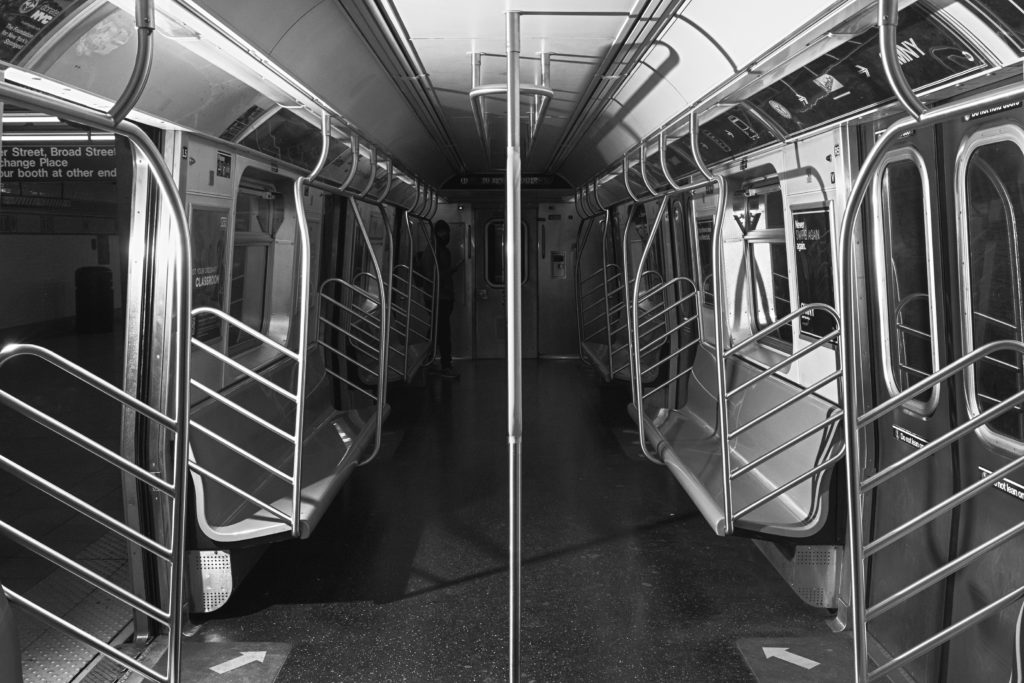
Kathy Ryan: What was it like to be in the epicenter of the pandemic, photographing in New York’s hospitals during this crisis? How do you prepare for something like that?
Philip Montgomery: I’m not sure there was a way to really prepare. I wasn’t necessarily in panic mode, but it was a feeling of all-hands-on-deck in thinking about how we were going to cover this in the city. You and I had discussed it: “Well, let’s do ride-alongs with paramedics.” “Let’s look at the USNS Comfort.” But I think we both knew that this story was best told inside the hospitals. That was priority number one.
Ryan: Yes.
Montgomery: When we ended up getting access to nine of the eleven of New York’s public hospitals, which was a breakthrough moment, I don’t think we really knew what to expect. We were following the statistics, but you have no way of knowing how that’s going to look. So in terms of preparation, I didn’t really know what to prepare for, emotionally or visually. On the safety front, we were so terrified that we went above and beyond with the PPE, and I’m happy we did, but thinking back on it, maybe some things were a little bit unnecessary.
But what we weren’t prepared for was the sheer volume of patients at the peak of the pandemic in New York. As I talk to you now, I have the contact sheet of the shoot at Queens Hospital Center in front of me, and I’m looking through the images, frame by frame, of walking in there, from the first picture to the middle of the take. I remember feeling completely overwhelmed by what we were seeing. I remember feeling really emotional and, at times, was even in tears.


Ryan: Why did you choose to use a handheld strobe to illuminate the scenes you were documenting?
Montgomery: It was pretty immediately clear that was what needed to be done. The light within hospitals is really clinical and flat, and there is so much going on in the space, so the way that I used the light was to enable me to isolate certain scenes and moments. I had to set up parameters within the hospital. HIPAA law dictates that only individuals who had consented to photography could be photographed. And using that light actually helped me to isolate those individuals and frame out the other elements that weren’t supposed to be seen in the photographs—unconsenting patients, or patients who were on ventilators, or patients who were being admitted into the ER.
Ryan: The light is obviously part of your signature. In our editing, we also spent a lot of time dealing with privacy issues. It was an overwhelming part of this particular project. It’s so unusual to have that kind of access in a hospital, and we wanted to be respectful of patient privacy.
At one point, you photographed fire department paramedics who were resuscitating a coronavirus patient who had gone into cardiac arrest when he stopped breathing. What was that like for you? There you are, you’re making pictures, and now you’re seeing a life-and-death moment.
Montgomery: It was like a movie being played out in front of me in real life. There were beds and beds and beds. There was barely any walking space within the emergency department at that time, and the room was already high-intensity. Much like you’d see in a television show like ER, these paramedics rushed in with the gurney and didn’t really have time to station a man in a specific spot, and they were working to save his life in the middle of the unit. It had to be done right there. I watched the two paramedics taking turns, administering chest compressions to the point where I’m pretty sure they had broken the man’s chest plate. It was this profound, cinematic moment—you just couldn’t believe it was really happening. But for those working in the ER, this sort of thing happened all day, especially in the time of COVID.
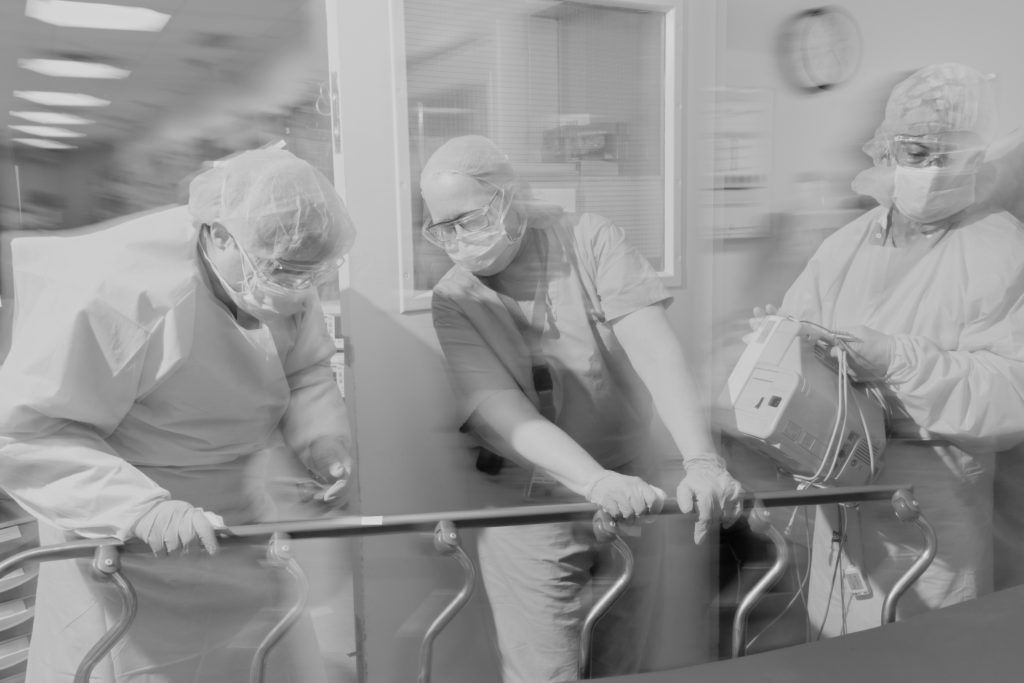
Ryan: What was your interaction like with the health-care workers? How do you communicate when there’s that kind of chaos unfolding?
Montgomery: I would try to read the room. Everybody was in N95 masks and face shields. I could see through the shield, and so if someone’s eyes locked on me, I could nod. I could sense how they were feeling, and how busy they were. A lot of the time, I was just trying to stay the hell out of the way.
The set of questions I always asked was: “What do you want us to see? What is important for the public to see?” Given the moment with COVID, a lot of doctors were pretty clear about what they wanted to convey to the world, and they largely wanted to reinforce how serious the situation was.
Ryan: In addition to documenting the news and capturing the first visual draft of history unfolding, many photojournalists hope and think and believe that the work they do will provoke some kind of change. What were you hoping the photographs in the hospitals would do in terms of provoking change?
Montgomery: After all that I had seen, I was hoping they would terrify and galvanize the public into taking preventive measures recommended by scientists, namely social distancing and mask wearing. I was hoping the photographs would spark a collective show of respect for the severity of the disease and the sacrifices by the frontline workers combating it.
How did you feel, as the director of photography at the magazine, receiving those pictures?
Ryan: I was shocked. When the pictures came in, it was worse than I could even have imagined—the amount of people crowded into the rooms in the hospital, and the number of health-care workers who were there. It was literally like nothing I’d seen. The project was so emotionally wrenching, partly because of what we were seeing in the hospitals, the speed we were working at, the risks you were taking, and the fact that it was in our own city. Honestly, that did make it different.
We had all just left our lives as we knew them. We’ve vacated our offices. We’re working from home. And we’re producing this photo-essay that’s going to be extremely important, and hopefully have exactly the impact you were hoping for—which would be to get people to change their behavior and wear masks. This was in March, when there was still a lot of trying to convince people how serious COVID was and how important it was to wear masks and social distance. I felt acutely the unusual experience of producing and editing the photographs while, at the same time, living through this heartrending moment in our city’s history. When this issue came out, the response was huge. It was the first, I think, really major moment when a photo essay kind of showed what it was like, showed everything.
As you were working in the hospitals, it sadly became clear that the next part of your coverage of the pandemic in New York would be to photograph how New Yorkers are mourning their dead. In April, we arranged for you to spend time at the Farenga Brothers Funeral Home in the Bronx. The idea was that you would photograph the Farenga brothers as they guided families through the mourning process, and you would photograph the families mourning their lost loved ones. One of the first things you did was photograph Nick Farenga retrieving one of those bodies out of a trailer outside a hospital. How did you find the strength to make pictures witnessing that?

Montgomery: I never quite know how to answer that question. The responsibility of the task at hand far outweighs any sort of internal conflict I may have. When I’m working on stories of this significance, there’s not much consideration for myself. There’s no question of, Can I do this or can I not? I absolutely must.
When I was photographing in the hospitals, the refrigerated trucks being used as temporary morgues were a dark reality, but they were also a mystery. In order to convey the urgency of the pandemic, the public needed to see inside these hidden places. So when we gained access to a funeral home, I thought it was an imperative piece of the story.
The scene inside the funeral home was the evidence. There were bodies stacked on top of bodies. Nick, one of the funeral directors, had to retrieve a body for a family, and he had to move multiple bodies from the shelves to do so. It was completely surreal. He was professional, and at that point he’d done this countless times. For him, it was just work. For me, being there was work as well, but it required another level of focus and sensitivity.
Ryan: I felt you showed a tenderness on the part of Nick and Sal Farenga. That is difficult, harsh stuff, lifting a body bag off the shelf. The moment that you captured, there’s a tenderness to the way that he’s holding it, and his head is bent down. I only wanted to mention that because you’ve got to make pictures that people can bear to look at.
At the time, New York was becoming totally unbearable for everyone—for the people who were losing people, for the people who were trying desperately to save lives. It was just a difficult, difficult time. And you want people to be able to look at this picture. And a lot of people think, Oh, I can’t look at that picture inside that trailer, with all the bodies stacked up on the shelves. We never would have thought we’d see something like that in the city.
I felt something similar in your photograph of Sal preparing a body for the embalming procedure, a close-up of his gloved hand as he’s washing the hand of the body. There’s something about it that feels almost religious. What is your memory of that one?
Montgomery: Sal and Nick are tough men. But when they were doing their work, they implemented a sensitivity that was really surprising and beautiful. I say surprising just because of their demeanors. They’re from the Bronx. They’re a little rough around the edges. So that juxtaposition was striking.
In the photograph that you’re describing, while Sal’s embalming a body, he’s carrying on a conversation with one of his staff members, and it’s like how you or I would talk to a colleague in the office, but he’s also still, at the same time, displaying this great respect for the process. I think that’s why the picture presented itself to me. His hands were so delicate in handling the hands of the deceased.
I’m sure, in your job at the magazine, you have to ask, How do you show bodies of the deceased? Does that change if they are Americans or foreigners? You must have had this conversation many times throughout your career. It’s harder for an American readership to see stories close to home. What were the internal discussions around that, especially considering this story was in our backyard?
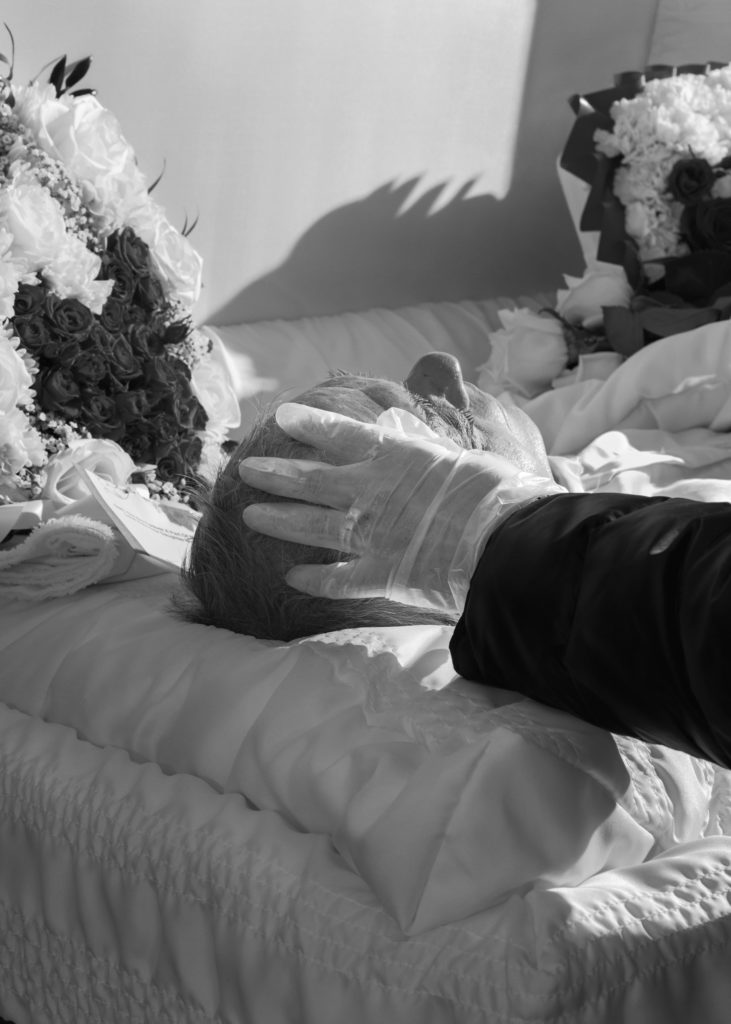
Ryan: We approached it with tremendous care, and every step of the way we were extremely careful to protect the privacy of the patients. It was hard to do the story without showing bodies, and we were committed to making sure that with every picture we showed one could see that the body was being treated with dignity.
The Purewal family agreed to give you full access to document the funeral service of Paramjit Singh Purewal. Mr. Purewal’s wife had just recovered from COVID herself and been released from the hospital in time to mourn her husband. For the cover of that issue, we decided to go with the picture of Mr. Purewal lying in the casket, and his wife is stroking his head, and her hand is gloved. So the gloved hand indicates this moment in time, this year of 2020, with COVID, and the fact that she had to wear gloves to touch her deceased husband one of the last times she’s going to see his body.
Right up until the end, I was very nervous and concerned and hopeful that the Purewal family would be okay with this decision. We don’t seek approval for how we’re going to use the pictures in the magazine. It’s understood that they know they’re being photographed for The New York Times Magazine and that, ultimately, we’ll decide which images to use. But in this particular photo-essay, I remember wanting to be confident that the family members would feel good about the picture because it was very courageous of the Purewal family to agree to this project. You managed to make brutally honest documentary pictures of the horrendous loss of lives and, at the same time, incredibly honest pictures of tender love, just gentle enough that the people who were pictured in them were accepting of the images.
Montgomery: In each of those scenes, and in other stories I’ve worked on where I’m meeting someone on arguably the toughest day of their life, whether that’s an opioid overdose or a funeral in the wake of COVID, I ask myself, What if that were my father or my mother?
I thought that cover image spoke to how our process of mourning, and our process of engaging death in the time of COVID, has dramatically changed, and how traumatic that could be for a family, from New York, where the funeral homes were completely overwhelmed, funerals were limited and socially distanced, and a lot of New Yorkers were begging funeral homes to help them retrieve loved ones whose bodies had been stored in these trailers for days or weeks.
Ryan: Being denied the chance to even attend the funerals of their loved ones.
Montgomery: Exactly.
Ryan: I also think the cover image, because of the light that you brought to it, gave it a little bit of a celestial feel. Without that deft lighting, the picture might not have transcended to the degree that it does, where it feels spiritual.
Montgomery: At the magazine, news moves at a different cadence. But when you have these moments, 9/11, or the peak of the pandemic in New York, where does your mind go as a photography director, when a story is dominating the whole world? What was your headspace at the beginning of the pandemic?
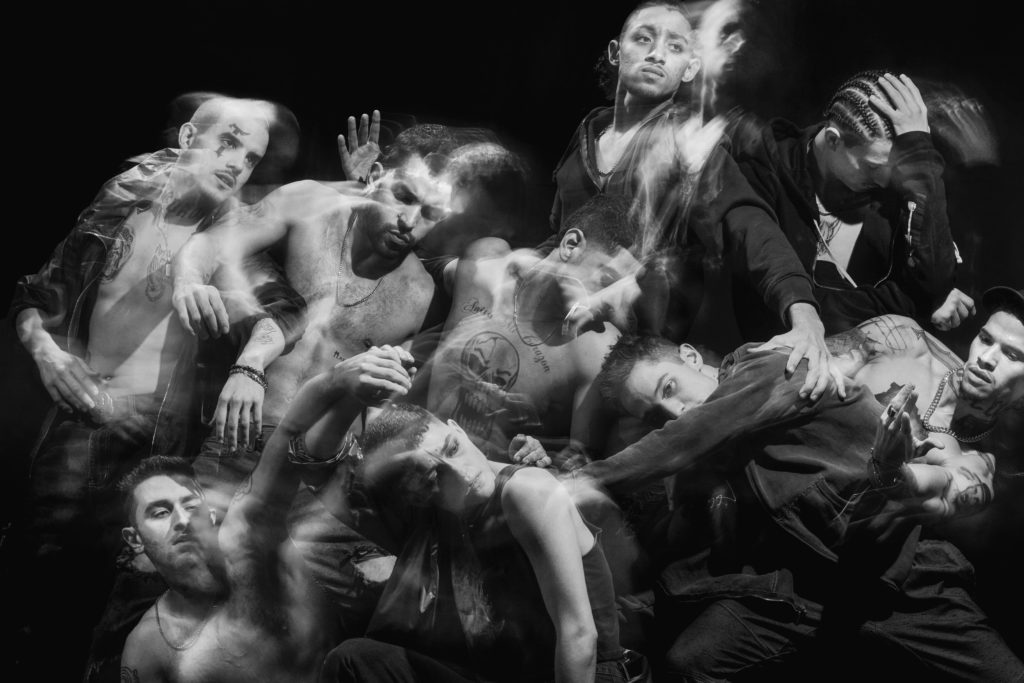
Ryan: I would say it all started with Jake Silverstein, the editor in chief of The New York Times Magazine, literally on the night before we vacated the New York Times building for what’s now turned out to be at least a year. Who knew? We thought we’d be back in weeks. The COVID crisis was huge at that point in Italy, and it was really just starting to become the issue that it became in New York. Jake said that the story was going to be huge, and be with us for months, and that he wanted to cover it in a big way photographically.
So I knew what I needed to do. I said we should put you on assignment for a month. When I first reached out to you, we didn’t even know what we were going to be covering. The likelihood was it would be the hospitals. Clearly that was at the top of the list. But at that point, we didn’t have an actual assignment, to say, “We’d like you to go to the hospitals tomorrow and the day after.” We weren’t there yet. But it was very clear that major things were happening, and happening in our city, and I desperately wanted us to be able to document it.
Your pictures make people slow down. They make me think of the sort of golden era of Life magazine, when people really stared at a picture. It’s so hard now, with everybody looking on their phones, and pictures go by so quickly. Before the COVID crisis took hold, the last assignment you had done for us, in January, was to go into the studio on a big theatrical shoot. We were doing a cover story coming up on the remake of West Side Story on Broadway, and literally the weekend before it was due to go into previews, we got permission and access for you to photograph the whole cast of dancers and singers in the studio. The producer of West Side Story arranged for them to go there on a Sunday, and theyspent a long day with you.
You got them dancing, singing, reenacting scenes from the musical, doing their own thing—a little bit of everything. It was an extraordinarily joyous day. The youthful energy and enthusiasm and excitement was bouncing off the walls, because for the majority, I think about thirty of these actors, it was their first Broadway role. It just was magical.
In a way, it’s almost like I still cannot believe that none of us that day, none of us, could have anticipated that within two months all Broadway shows would be shut down, theaters would go dark. These poor actors are out of a job. This iconic picture of them, which I thought just defined youth and vitality, ends up being ancient history within two months.
Montgomery: I don’t know about you, but that was the last time I had fun with the craft of photography. The last photographs I made before the pandemic were during a studio shoot with Matthew McConaughey in LA. Since then, I’ve photographed New York’s empty streets, COVID testing sites, Wall Street as the stock market crashed, John F. Kennedy Airport as it shuttered. Last year, two days before Thanksgiving, I photographed the Rainbow Room on top of Rockefeller Center. The initial excitement at seeing the skyline quickly gave way to sadness. Being up there, I began to unpack the profound transformation both our city and our nation had experienced.
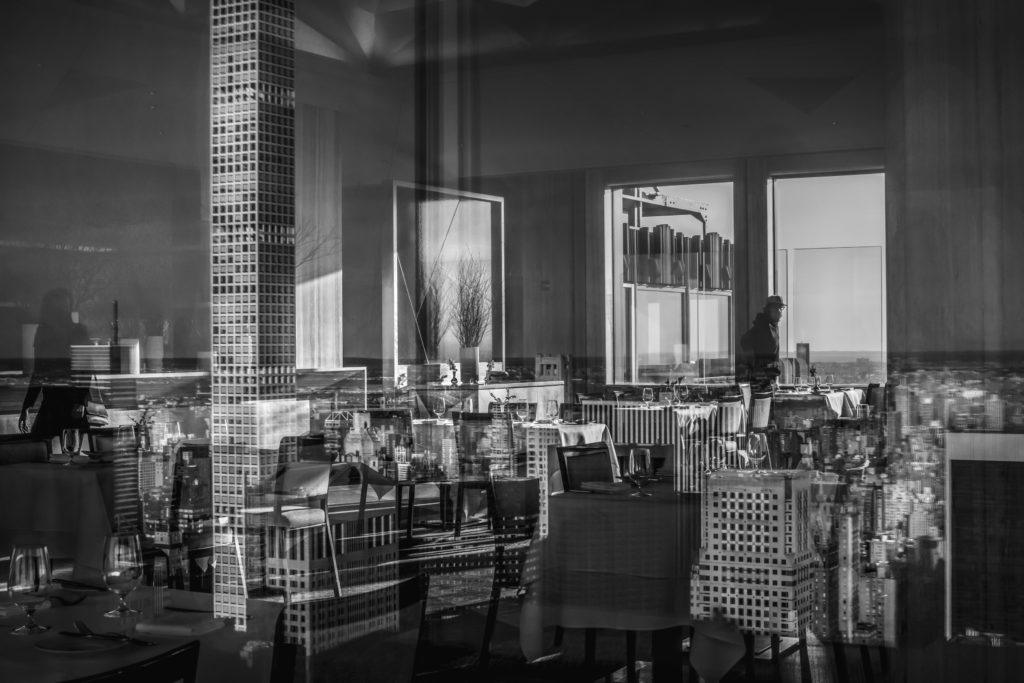
All photographs courtesy the artist
Ryan: The first couple of months of the pandemic, when I would look at this picture of the West Side Story cast, so happy and full of excitement about their future, it would make me sad. Now, I look at it and have a different reaction—it’s a picture about faith. You’ve got to have faith in New York.
Montgomery: Absolutely. What I’m so proud of in this city is the collective understanding of what we all experience as one. Since those photoshoots, I’ve traveled a bit throughout the country, and nowhere else is operating like New York in terms of being cautious and considering thy neighbor. That gives me optimism in our path forward. At the beginning, we would see people flee the city—at the first sign of trouble, folks were out. For you and me, people who are over the-top in our love for New York, it’s like, What? Are you crazy? We go down with the ship.
This article originally appeared in Aperture, issue 242, “New York,” under the title “Life and Death in an American City.”
Philip Montgomery’s first monograph, American Mirror, will be published by Aperture in fall 2021.










